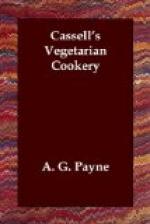SAGO PORRIDGE.—Wash the sago in cold water and boil it in some water, allowing about two tablespoonfuls to every pint; add pepper and salt and let cold milk be served with the porridge.
MILK TOAST.—This is a very useful way of using up stale bread. Toast the bread a light brown, and if by chance any part gets black scrape it gently off. Butter the toast slightly, lay the toast on the bottom of a soup-plate, and pour some boiling milk over it. Very little butter should be used, and children often prefer a thin layer of marmalade to butter.
CHAPTER IV.
EGGS (SAVOURY) AND OMELETS.
EGGS, PLAIN BOILED.—There is an old saying that there is reason in the roasting of eggs. This certainly applies equally to the more common process of boiling them. There are few breakfast delicacies more popular than a new-laid egg. There are few breakfast indelicacies more revolting than the doubtful egg which makes its appearance from time to time, and which may be classed under the general heading of “Shop ’uns.” It is a sad and melancholy reflection that these more than doubtful “shop ’uns” were all once new-laid. It is impossible to draw any hard-and-fast line to say at what exact period an egg ceases to be fit for boiling. There is an old tradition, the truth of which we do not endorse, that eggs may arrive at a period when, though they are not fit to be boiled, fried, poached, or hard-boiled, they are still good enough for puddings and pastry. There is no doubt that many good puddings are spoilt because cooks imagine they can use up doubtful eggs.
When eggs are more than doubtful, they are often bought up by the smaller pastry-cooks in cheap and poor neighbourhoods of our large towns, such as the East-End of London. These eggs are called “spot eggs,” and are sold at thirty and forty a shilling. They utilise them as follows: They hold the egg up in front of a bright gas-light, when the small black spot can be clearly seen. This black spot is kept at the lowest point of the egg, i.e., the egg is held so that this black spot is at the bottom. The upper part of the egg is then broken and poured off, the black spot being retained. The moment the smallest streak proceeds from this black spot the pouring-off process is stopped. Of course, the black part is all thrown away, the stench from it being almost intolerable, containing, as it does, sulphuretted hydrogen. We mention the fact for what it is worth. It would be a bold man who tried to lay down any law as to where waste ceases and the use of wrongful material commences. Everything depends upon the circumstances of the case in question. We fear there are many thousands, hundreds of thousands, in this great city of London, whose everyday life more or less compares with that of a shipwrecked crew. They “fain would fill their belly with the husks that the swine do eat, but no man gives unto them.” There is this to be said in favour of vegetarian diet—that, were it universal, grinding poverty would be banished from the earth. We must not cry out too soon about using what some men call bad material. Lord Byron, when he was starving after shipwreck, was glad to make a meal off the paws of his favourite dog, which had been thrown away when the carcase had been used on a former occasion.




